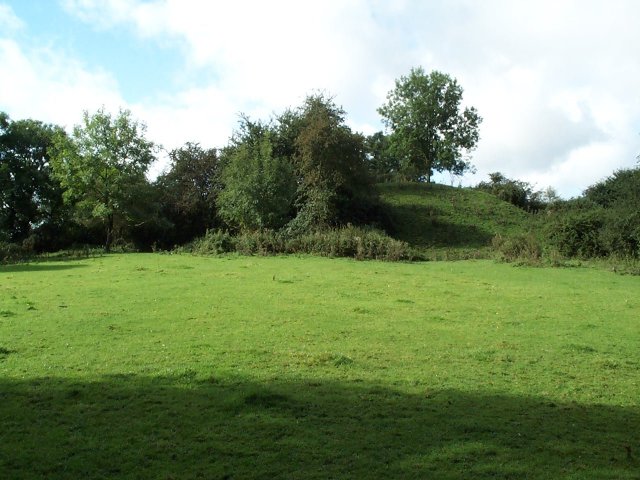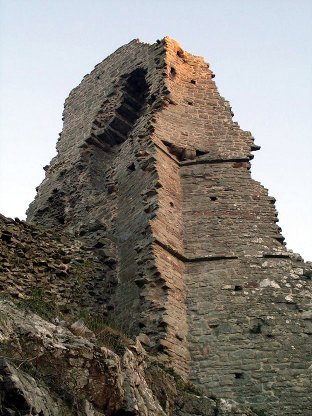Montgomery
With Montgomery castle we are lucky to have many original documents describing the building, garrisoning and even everyday life within the fortress. It is unusual to have this level of depth in a castle study. The original castle at Montgomery, now known as Hen Domen, was founded by the powerful Montgomery family, earls of Shrewsbury from 1071 to 1102. This castle passed to the Boulders family after the rebellion of the last Montgomery earl of Shrewsbury in 1102. At this time it was the centre of a five knights' fee barony. This means that the castle and associated lands were held of the king by the service of knights and their retinue by the Boulders family.
 The motte of Hen
Domen castle as seen from the bailey [left], came
into the hands of King
John early in the thirteenth century. In 1215
Prince Llywelyn ab Iorwerth swept into Shropshire and destroyed the
castle in his victorious Shrewsbury campaign. Eight years
later, King John's son and heir, the sixteen year old King Henry III
(1216-72), came to Montgomery and on his birthday decreed that a new
castle would be built at Montgomery on the site of the current castle
rock. Soon afterwards he also ordered the building of the new
town of Montgomery which was also fortified. At King Henry's
side when the castle was founded was his justiciar, Hubert Burgh.
Hubert was a valiant soldier and had doggedly defended both
Chinon in Anjou in 1205 and Dover in Kent in 1216 for King John. In the
1220's and 1230's he was also responsible for largely rebuilding the
three castles of the Trilateral,
Skenfrith, Grosmont and White Castle. Montgomery
castle shows many features seen in these fortresses.
The motte of Hen
Domen castle as seen from the bailey [left], came
into the hands of King
John early in the thirteenth century. In 1215
Prince Llywelyn ab Iorwerth swept into Shropshire and destroyed the
castle in his victorious Shrewsbury campaign. Eight years
later, King John's son and heir, the sixteen year old King Henry III
(1216-72), came to Montgomery and on his birthday decreed that a new
castle would be built at Montgomery on the site of the current castle
rock. Soon afterwards he also ordered the building of the new
town of Montgomery which was also fortified. At King Henry's
side when the castle was founded was his justiciar, Hubert Burgh.
Hubert was a valiant soldier and had doggedly defended both
Chinon in Anjou in 1205 and Dover in Kent in 1216 for King John. In the
1220's and 1230's he was also responsible for largely rebuilding the
three castles of the Trilateral,
Skenfrith, Grosmont and White Castle. Montgomery
castle shows many features seen in these fortresses.
 The fortress,
begun in stone from the first, still towers above Montgomery town.
The main feature of the military fortress was a great
twin towered gatehouse, the ruins of which can be seen opposite.
This massive structure stood upon a boss of rock that was
additionally protected by a great man made ditch. Work on the
castle progressed rapidly. The king began preparing wood for
the fortress on 8 August 1223, decided on the site of the castle on 30
September and had an operational citadel on the site by 22 November.
From then until 1228 masons worked solidly building the
entire inner ward, or donjon as it was then known. This
consisted of the gatehouse opposite, two D shaped towers and the
apartments which crowded around the curtain wall. In 1228
the castle was given to the new created earl of Kent, Hubert Burgh.
That same August Montgomery castle withstood its first siege
by the Welsh prince, Llywelyn ab Iorwerth (d.1240). As a result of
this attack by early 1229 Hubert had begun building the middle ward.
By December of the same year work was in progress to fortify
the 'outer wards'. To all intents and purposes Montgomery
castle had reached the extent it still occupies today. The
completion of the castle did not mean that the garrison and townsfolk
were safe. In May 1231 a Welsh force was ambushed outside the
castle in the first battle of
Montgomery.
As a result of this defeat the local Welsh returned the next
month, surprised the town and burned it. Despite this attack,
the
castle remained inviolate.
The fortress,
begun in stone from the first, still towers above Montgomery town.
The main feature of the military fortress was a great
twin towered gatehouse, the ruins of which can be seen opposite.
This massive structure stood upon a boss of rock that was
additionally protected by a great man made ditch. Work on the
castle progressed rapidly. The king began preparing wood for
the fortress on 8 August 1223, decided on the site of the castle on 30
September and had an operational citadel on the site by 22 November.
From then until 1228 masons worked solidly building the
entire inner ward, or donjon as it was then known. This
consisted of the gatehouse opposite, two D shaped towers and the
apartments which crowded around the curtain wall. In 1228
the castle was given to the new created earl of Kent, Hubert Burgh.
That same August Montgomery castle withstood its first siege
by the Welsh prince, Llywelyn ab Iorwerth (d.1240). As a result of
this attack by early 1229 Hubert had begun building the middle ward.
By December of the same year work was in progress to fortify
the 'outer wards'. To all intents and purposes Montgomery
castle had reached the extent it still occupies today. The
completion of the castle did not mean that the garrison and townsfolk
were safe. In May 1231 a Welsh force was ambushed outside the
castle in the first battle of
Montgomery.
As a result of this defeat the local Welsh returned the next
month, surprised the town and burned it. Despite this attack,
the
castle remained inviolate.
 In
1232
Hubert fell from favour and the castle was again resumed by the crown.
Some time in September 1233 the Welsh again attacked Montgomery and
possibly damaged the castle for the well tower, opposite, had to be
repaired and roofed in lead. Several other castles of Hubert
were
also re-roofed with lead under Henry III, so perhaps this was merely a
precaution on the king's part. In June 1244 the Welsh again
attacked Montgomery castle at the start of a new war, and once again
managed to burn the town. The people of Montgomery under the
castle garrison soon gained their vengeance, routing a Welsh army in
sight of the castle walls by a careful stratagem in February 1245.
In 1251 much of the middle ward was rebuilt in stone and the
outer gatehouse was constructed. Three years later the castle was
munitioned for siege with 6,000 crossbow bolts.
In
1232
Hubert fell from favour and the castle was again resumed by the crown.
Some time in September 1233 the Welsh again attacked Montgomery and
possibly damaged the castle for the well tower, opposite, had to be
repaired and roofed in lead. Several other castles of Hubert
were
also re-roofed with lead under Henry III, so perhaps this was merely a
precaution on the king's part. In June 1244 the Welsh again
attacked Montgomery castle at the start of a new war, and once again
managed to burn the town. The people of Montgomery under the
castle garrison soon gained their vengeance, routing a Welsh army in
sight of the castle walls by a careful stratagem in February 1245.
In 1251 much of the middle ward was rebuilt in stone and the
outer gatehouse was constructed. Three years later the castle was
munitioned for siege with 6,000 crossbow bolts.
The ensuing Welsh war did not go well for the men of Montgomery. First in January 1257 the castle garrison was routed on its way to Powis castle outside Welshpool. Then in March Montgomery town was again burned by the Welsh and in May the castle garrison was again defeated at the battle of Gwernesgof. The castle, however, remained impregnable and in the summer of 1264 a Marcher army under the command of Roger Mortimer of Wigmore sheltered within its walls from the forces of the barons under the nominal leadership of King Henry III (1216-72) and Prince Llywelyn ap Gruffydd (1246-82). Finally in 1267, the momentous treaty of Montgomery was signed, which was thought to mark the end of the Welsh wars. However war was soon resumed and it was the army of Montgomery that set out on a cold December night in 1282 that finally met with and killed Prince Llywelyn at the battle of Llanganten outside Builth Wells.
In the period after the fall of Llywelyn, Montgomery castle was refurbished and the town walls were built. The castle once more saw action in 1294-95 when the earl of Warwick formed the army of Montgomery, which on 3 March 1295 destroyed the army of Prince Madog ap Llywelyn at the battle of Maes Madog. After this Montgomery was allowed to gradually decay, mainly being used as a royal prison. However in the Tudor period the castle was again renovated and saw much use as a mansion in the seventeenth century. The castle was finally almost totally demolished in 1649 when parliament was removing obnoxious strongholds from the realm.
The Henrician castle was rapidly built in 5 years and by 1228 consisted of an unusual twin towered gatehouse with solid D shaped towers. More normal versions of such a gatehouse are described under Caerphilly castle. Montgomery castle also had a massive D shaped tower which housed a 200' deep well and a smaller D shaped tower which has now gone. The ridge on which the inner ward stood was fronted by a massive rock-cut ditch. This first castle was soon reinforced by an outer ward, with a smaller twin towered gatehouse. In time this was strengthened by further outworks and the town wall which surrounded the borough below the great crag on which the castle was set. Montgomery is also the first castle in the UK to be immortalised in print, with Matthew Paris (d.1259) drawing it in one of his books.
Montgomery Castle, a royal fortress of King Henry III (ISBN 1-899376-49-6), is now available as an A4 sized book of 174 pages. The revised book includes the full history of the Medieval castle, church and town, a detailed description of the remains, new photographs of the fortress after the recent CADW renovations, plans, maps and an index. It can be bought for £34.95 through the PayPal basket below.New Series!